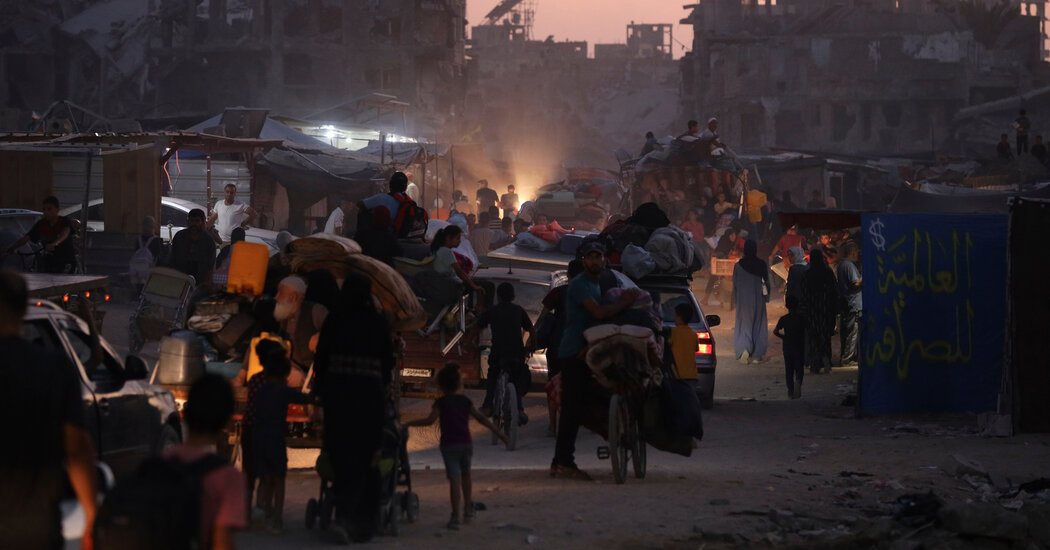Israel issued a new round of evacuation orders for a large swath of the southern Gaza Strip on Tuesday, sending thousands of Palestinians fleeing once again for relative safety.
In recent weeks, Israeli officials have spoken of moving toward narrower, more targeted attacks, but the exodus taking place in the city of Khan Younis made it clear Tuesday that for Gazans, a return to ordinary life is not close.
Gazans who had already been forced to flee again and again were once more on the move, hauling piles of their belongings on cars, trucks and donkey carts. Hospital patients were pushed in wheelchairs alongside others who fled on foot.
“How long can we keep being ordered: Leave and come back, leave and come back?” wondered one Gazan, Suzan Abu Daqqa, 59, after fleeing her home southeast of Khan Younis.
The trigger for the evacuation orders appeared to be a barrage of roughly 20 rockets that the Israeli military said had been fired from Khan Younis by Palestinian militants a day earlier. Israeli forces struck back overnight after “enabling civilians to evacuate from the area,” the military said.
The United Nations estimated that some 250,000 people will have to flee large areas of southern Gaza to comply with the new orders. Scott Anderson, a senior U.N. official, said the calculation was based on prewar population data and anecdotal observations of how many people had returned to the area.
The pattern of repeated civilian displacement is likely to continue even as the Israeli military speaks of a “lower intensity” war, military analysts say. As militants regroup, Israeli forces have been returning to areas from which they had once withdrawn to wage days-long crackdowns.
For many Gazans, these new operations are far from low-intensity.
The fighting has been pitched, for example, in northern cities like Shajaiye, Jabaliya and Zeitoun. In Jabaliya, over 60,000 people fled their homes, according to the United Nations, returning to find widespread devastation.
On Tuesday, the United Nation’s top coordinator for humanitarian aid for Gaza, Sigrid Kaag, said that the vast majority of Gaza’s roughly 2.2 million people had been displaced over the course of the war — many of them multiple times. She put the figure at 1.9 million people.
Israeli forces largely withdrew from Khan Younis in April after months of fighting, as they were gearing up to invade Rafah farther south. In the relative calm of that withdrawal, Ms. Abu Daqqa returned.
When she arrived at her house on the southern outskirts of the city last month, she found it relatively unscathed by the heavy Israeli bombardment that had destroyed large parts of Khan Younis. It even had running water.
But on Monday evening, Ms. Abu Daqqa and her family heard that the Israeli military had yet again ordered an evacuation of the city. The all-too-familiar sound of artillery fire began, she said, prompting her to flee northwest with relatives.
Her family joined thousands of people who filled the streets of the demolished city on Monday night as they headed toward the Mawasi area near the coast, which Israel has designated as a “safer zone.”
On Tuesday, Khan Younis residents said most of the explosions they could hear appeared to be farther south, in Rafah. But they worried that the wide-scale evacuation order might herald a renewed military operation in their own city, too.
Israel’s prime minister, Benjamin Netanyahu, said Monday that the miliary would continue to operate in Gaza after the Rafah offensive ends to prevent Hamas from reclaiming control. The invasion began in October after Hamas led a bloody cross-border attack on Israel that the government says left about 1,200 dead and 250 taken hostage.
Amir Avivi, a retired Israeli brigadier general, said Israeli troops would seek to whittle away at Hamas’s remaining fighters, a process he said could take years. Over time, Israel hopes to erode Hamas’s forces so thoroughly that Gaza will take fewer and fewer forces to control, he said.
“Every time the terrorists manage to constitute themselves, there will be a raid to deal with them,” said General Avivi, who leads the hawkish Israel Defense and Security Forum. “These raids can last a few days or a week at a time — generally no more than a few days — and then you withdraw.”
Hundreds of thousands of people have flooded into Khan Younis and central Gaza since Israel began its Rafah operation, creating tent cities in which finding enough food and clean water is often a daily struggle. The humanitarian crisis has increased international pressure on Israel.
On Tuesday, the Israeli military said it had laid a power line to a desalination plant in Khan Younis to bolster its output. A senior Israeli military official said that the Ramallah-based Palestinian Authority would pay for the electricity and that UNICEF, the United Nations agency, would manage the plant.
Amid the panic stirred up by the newest evacuation order in Khan Younis, the European Hospital there ferried the majority of its medical staff and roughly 600 patients by ambulance to hospitals deeper into the city. Many of the doctors and patients there, scared by what they had seen in Israeli raids on other hospitals, were unwilling to take the risk of staying, said Dr. Saleh al-Homs.
He left the facility overnight, only to learn Tuesday morning that the Israeli military was saying there had been “no intention to evacuate the European Hospital.”
“Why did they wait until the hospital was evacuated to issue that statement telling us not to evacuate?” asked Dr. al-Homs. “People were terrified and desperate to get out.”
Jamal Azzam, a nurse at the hospital, said he had received phone calls from the Israeli military directing the staff to evacuate.
Four premature babies were sent by ambulance to Nasser Hospital in Khan Younis, Mr. Azzam said. Many families who were sheltering around the hospital in tents had also fled, he said.
“This is torture,” Mr. Azzam said.
